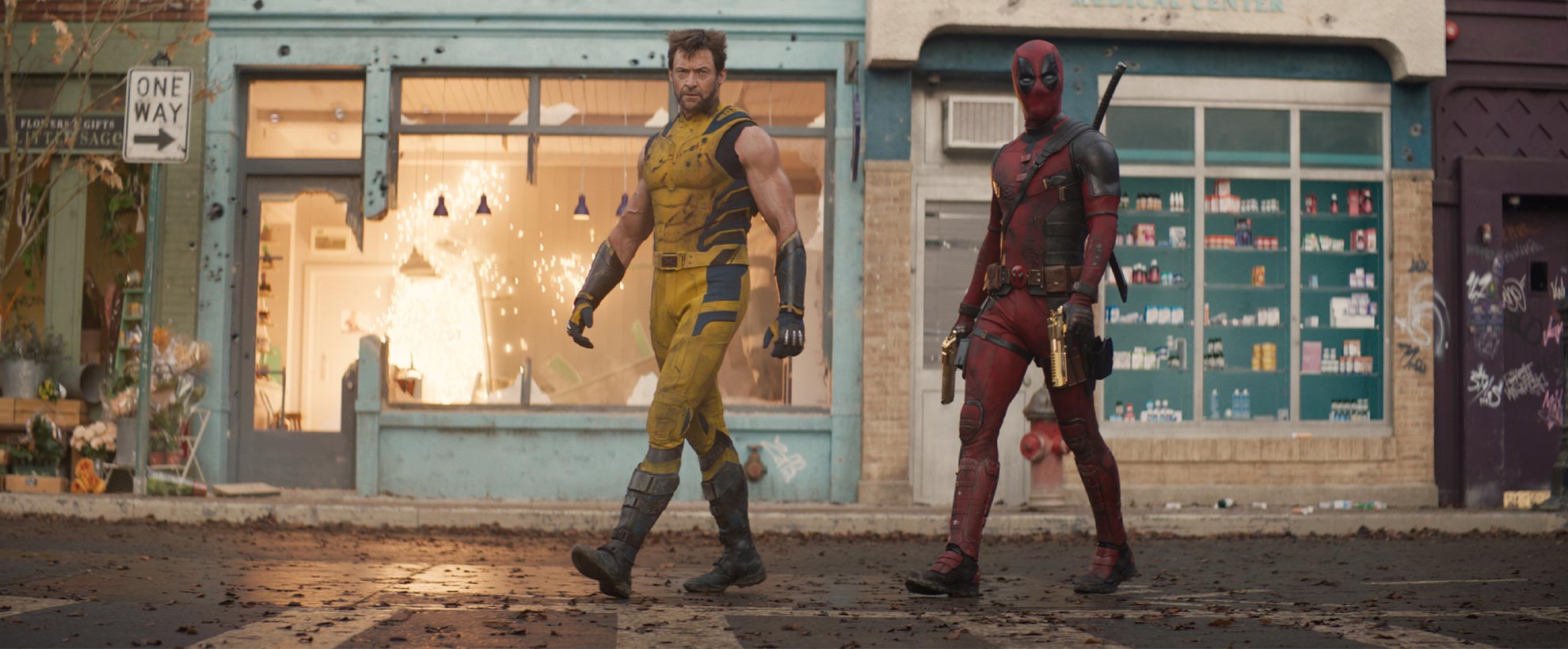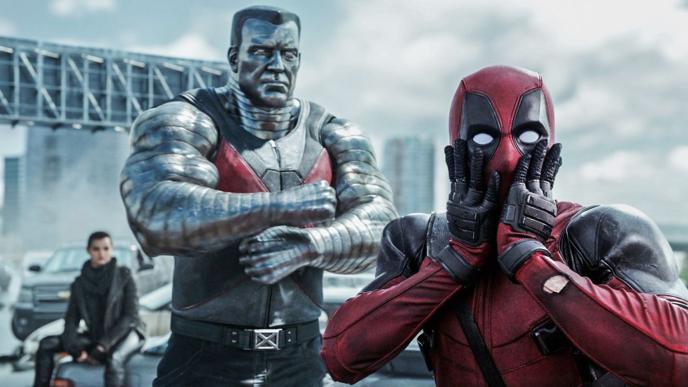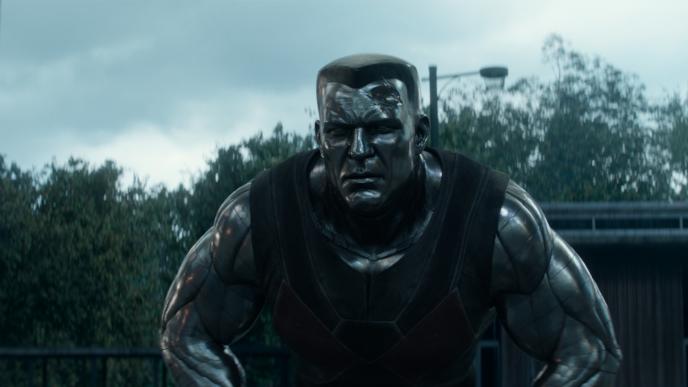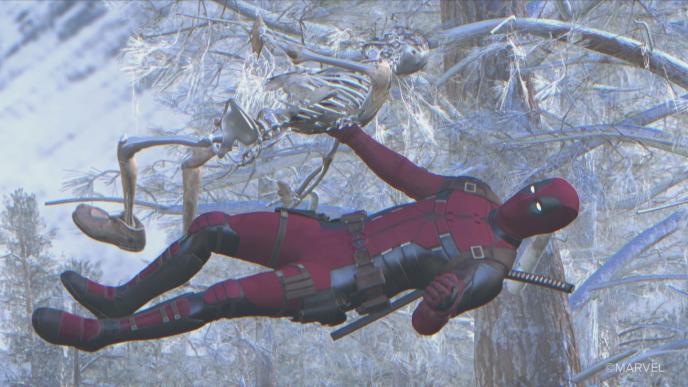
Deadpool & Wolverine
For its latest encounter with the Merc with a Mouth, Framestore embarked on a wild ride. From pre-production services—previz, on-set support, techviz, and postviz—to final VFX wizardry, Framestore brought the MCU’s first R-rated spectacle to life. Overseen by VFX Supervisors Matt Twyford (Loki), Robert Allman, Arek Komorowski, and João Sita, Framestore's VFX team delivered 420 supremely complex shots, building on the stellar groundwork laid by Framestore’s Pre-Production team (FPS), led by Senior Visualisation Supervisor Kaya Jabar.

Deadpool Corp and Oner sequences
The movie's third act begins with Deadpool and Wolverine battling the Deadpool Corps. Framestore created some of the coolest assets for this sequence, including Canadianpool, Headpool, and Babypool.

This impressive sequence consists of 200 shots, crafted by the talented team in Vancouver led by Arek Komorowski. It features an expansive metropolitan urban environment inspired by New York, Chicago and Vancouver, 120 stunts, dozens of digi-double take over, all of which required meticulous planning and preparation.
Having all the pre-production work done by Framestore’s FPS team had a huge impact on Framestore’s VFX team’s efficiency and preparation time. "Our FPS team planned the entire sequence in previz, programmed the motion control, supervised the shoot, and handled the postviz while we completed the final VFX,” says VFX Supervisor Matt Twyford. “By maintaining the concept throughout and having all the prep laid by Kaya and her team we were off to a flying start when it came to asset building, setting up cameras, look development, and cut arrangements." The intricate stunt work for this sequence spanned more than six months, demanding precise timing and coordination. The FPS team played a crucial role in helping the VFX team determine the exact timing, speed, and choreography for each stunt, including the complex bus jump shot. Following this, the VFX team faced a monumental compositing challenge to seamlessly integrate the various elements of this sequence.


"This sequence was a massive compositing challenge, requiring us to handle an enormous amount of data,” says Twyford. “We stitched together multiple plates and integrated over 400 layers of CG elements. Additionally, we simulated FX blood for 66 characters and body-tracked 67 characters. The result was an incredibly seamless and effective piece of invisible work.”
In Over Your Head
One of Framestore’s standout effects is guaranteed to leave a lasting impression: the sequence where Cassandra inserts her hand through TVA agent Mr. Paradox's (Matthew Macfayden) head and rummages around inside his brain in a grotesque and highly detailed shot.
This is something that has never been done before; it was almost a project on its own. It was technically original and creatively challenging. We leveraged our global resources to make this effect look as good as possible.

Using comic book references provided by the production team, Framestore’s VisDev team worked on early renders, providing realistic hand-painted visuals that allowed for quick iterations. This process was instrumental in refining the sequences, particularly the interaction between the hand and Paradox’s face. Once a satisfactory version was approved, the technical implementation began, ensuring high-quality and consistent results across all shots.

The VFX team started by creating a highly detailed digital double of Matthew Macfayden using an ultra-high-resolution Dorothy head scanner at Clear Angle in Pinewood Studios. Cassandra’s arm and fingers were also scanned to drive simulations. One of the main strategies was to bias the main skin interaction look to the animation stage. This approach required creating a custom animation rig for the animators to keyframe significant skin distortions and intersections quickly and accurately, maintaining the performance's integrity through to the final simulations.
"By biasing the main skin interaction look to the animation stage, we secured early signoff, giving us the confidence to move forward with big simulations and heavy renders, while achieving a more polished and consistent final effect," says Twyford.
Setting up the Maya rig involved creating a high-end FACS-based facial performance rig with hand-modelled, scan-based shapes, and a detailed hand rig enhanced by manually crafted PSD shapes. The rig needed to believably interact with the hand and fingers as colliders, giving animators an accurate representation in their viewports of what would later be rendered once the caches had undergone additional FX and shot-sculpting steps.
The FX setup was designed to be highly modular. This modularity allowed for the breakdown of all components contributing to the final skin effect, facilitating accurate fine-tuning of features such as wrinkle depth. “We distinguished hierarchically between folds, wrinkles, and micro-wrinkles,” says Global Head of Creatures, Markus Schmidt. “Like our rigging team, the FX team excelled at ensuring that the base setups could be applied to new shots, providing sensible initial results without requiring excessive manual adjustments. This efficiency enabled the delivery of many shots within a compressed timeframe and allowed for the transfer of effects to other assets.”


Maintaining Matthew Macfadyen's performance was another critical aspect. Despite having a high-resolution head scan and a full set of FACS, a significant amount of hand animation and head tracking was required to retain the actor's subtle performance nuances. The plate footage served as a reference to match and check small details consistently. The final touch for the believability of the slightly surreal hand-under-skin deformations was the use of numerous visual markers for realism, such as dynamic blood flow in lookdev, along with complex hierarchical skin fold and wrinkle behaviours.
“The effect is front and center in a lot of shots, leaving no room for error,” says Schmidt. “We wanted to make it look as real as possible so that audiences wouldn’t focus on how the effect was done but instead be fully engaged in the actors' performances and almost physically feel Cassandra’s fingers under their own skin.”
Magnifying Dogpool’s Eyes
Dogpool, portrayed by Peggy, crowned Britain’s ugliest dog, presented unique challenges. Although mostly practical, several shots required fully CG-enhanced eyes. The task involved replacing and animating the eyes while seamlessly blending CG elements to magnify them in live-action plates.


Framestore’s asset team in London developed the CG asset for Dogpool, focusing on creating photorealistic, yet comically exaggerated, eyes. This asset was then handed to the Melbourne team, led by VFX Supervisor João Sita, for integration into the shots. Along with eye animation, the team added quirky CG elements, including thick goggles above the eyes and a matching huggie earring to Nicepool.

“By just animating the eyes, we were able to give Dogpool a whole new character with more presence and intention in the performance,” says Twyford. “The challenge was finding and maintaining the right balance between realistic, photoreal eyes and the exaggerated, cartoonish style that allowed us to give Dogpool more character and emotion. All of this had to be achieved behind the thick goggles that magnify the eyes, so we had to consider the physics of the glass.”

Using human eyes as references, the team refined the iris, pupils, reflections, and meniscus to enhance the range of emotions. Eye animation was adjusted shot by shot based on the scene, dialogue, and actions Dogpool performed. This meticulous work included beauty lighting, reflections, and adjusting eye visibility through the visor.
We really focused on getting the eye to read right: the amount of white in the eyes, the performance of the eyes, and then the integration of the eyes and the goggles on top.


One of the main challenges was achieving the refraction effect with the 'goggly' look of Dogpool's eyes without too much distortion. "The animation team delivered a believable and engaging performance by iterating on the eyes before adding the goggles to ensure the performance was grounded in realism. We then rendered the scenes to verify that the magnification effect did not deviate from the desired animation and that the eyes were directed correctly. Maintaining the readability of the eyes while adjusting the whites and the wet look was crucial for emotional engagement and the overall performance," says Sita. The team also rendered multiple passes of the eye in lighting, allowing compositing to adjust the eyes’ shape and balance the refraction. “Compositing was crucial in fine-tuning our animation and integrating the elements in a grounded way. Although the eyes' performance can be a bit comical, it never detracts from looking realistic.”
It was a strong multi-site collaboration, and we worked hand in hand with other Framestore locations to get comps and pre-comps handed over between sites.
“Our collaboration with the London asset team also really helped us to seamlessly blend the CG elements with the plates. With them, we were able to fine-tune Dogpool’s asset, the fur’s groom that went over the goggles, and the design and shader work for the goggles and visor. We were able to deliver a fun, unique performance for the Merc with a Bark.”

Destroying the Time Ripper Machine: Spaghettification and Atomization
The climactic third act of Marvel's wildest and crudest movie couldn't have been better handled than by our London team, led by VFX Supervisor Robert Allman, whose work included delivering the sequence’s ‘spaghettification’ FX. “The final act is massive and really quite intricate,” says Twyford. “It deals with multiple storylines that we had to integrate simultaneously, some new, some old, some revamped from various Marvel projects, all coming together at a single point in time. This required us to rebuild old assets, create new ones, and merge them seamlessly.”


During this third act, Cassandra attempts to destroy the Time Ripper, a huge machine with complex mechanics and glass, fed by two sources of matter, capable of shredding timelines. Destroying it will ultimately annihilate all timelines in the universe. To stop this, Wolverine and Deadpool must short-circuit its energy supply. Our team handled this massive destruction sequence over 80 shots, and multiple layers of complex FX. From illustrating antinomic energy through Deadpool’s and Wolverine’s bodies, to the destruction of the Time Ripper machine and the ultimate, up-close atomization of Cassandra.
“Our FX artists delivered exceptional work, making this complex task appear effortless,” says Allman. “This challenging sequence involved intricate physics, creating geometric flesh being pulled off a digi-double that had to retain Cassandra's likeness. The digi-double work was done with meticulous precision. Cassandra is fully CG, but to achieve a convincing likeness, especially in the eyes, the team carefully restored her eyes and eyebrows to capture her expressions accurately. Their seamless blending work makes it nearly impossible to tell that it is a CG Cassandra.”

For this sequence again, the collaboration with FPS was crucial and streamlined the creative and production process. "Our FPS team's standard was impressively high. They excel in storytelling and narrative work, making them effective designers. While many VFX artists focus on simulation and realism, FPS brings a design perspective that enhances visual appeal,” notes Allman. “By using FPS layouts, we achieved better results instantly. Their ability to combine narrative needs with visual aesthetics is rare and significantly informed our work."

Press
- Framestore Serves Big Plate of Spaghettification for ‘Deadpool & Wolverine’ - AWN
- Deadpool & Wolverine: Matthew Twyford – VFX Supervisor – Framestore - The Art of VFX
- Framestore Brings Deadpool’s Most Meme‑able Star To Life - Ausfilm
- Framestore delivers pre-production and VFX on Deadpool and Wolverine - British Cinematographer
- Framestore gives Deadpool the Finger(s) - FX Guide
- Here’s how Emma Corrin’s hands went through Matthew Macfadyen’s face - Befores&Afters
- Corridor Crew Look at Deadpool & Wolverine - Corridor Crew
- Deadpool and Wolverine, crafting superbly stylized VFX for Marvel's over-the-top action comedy - CGW










